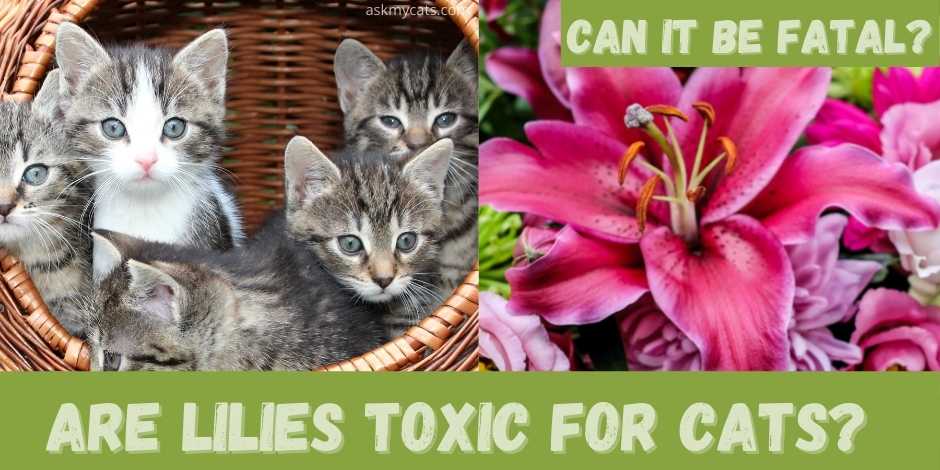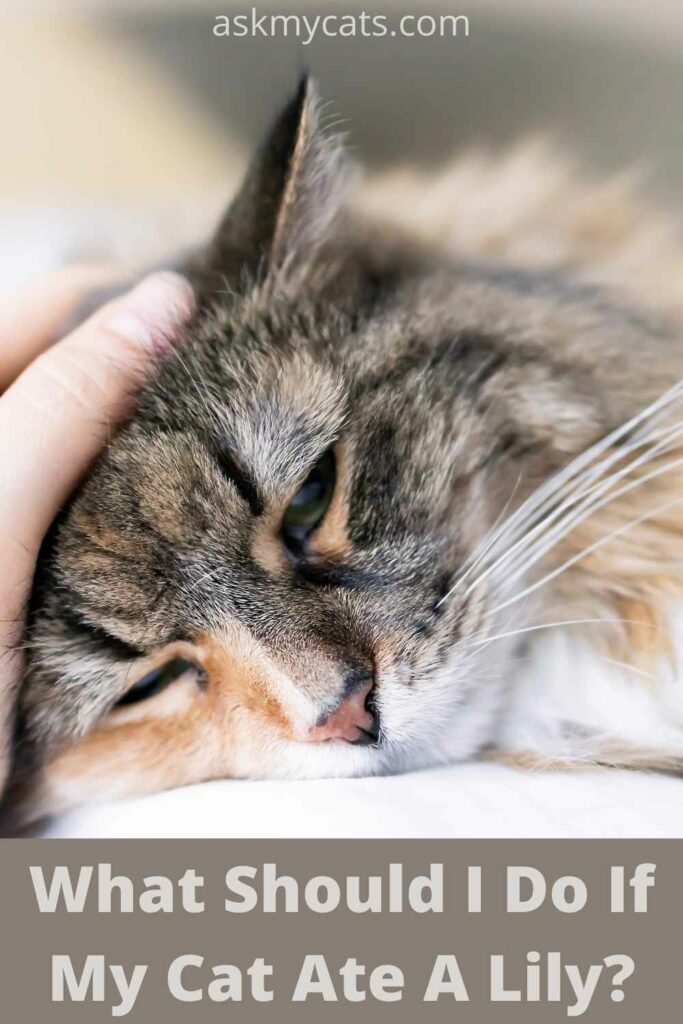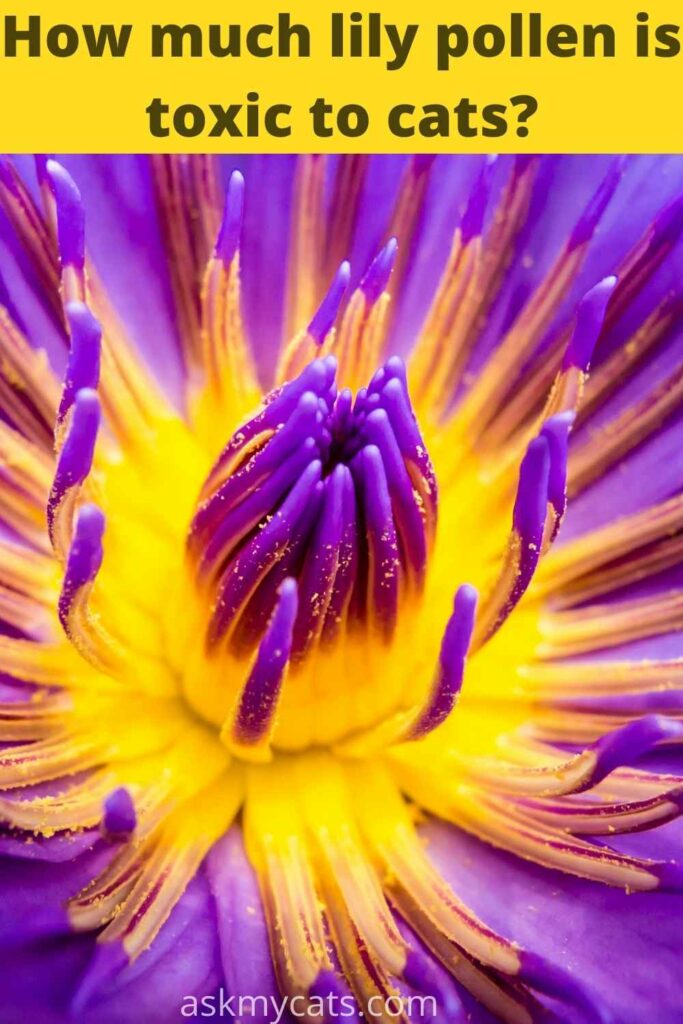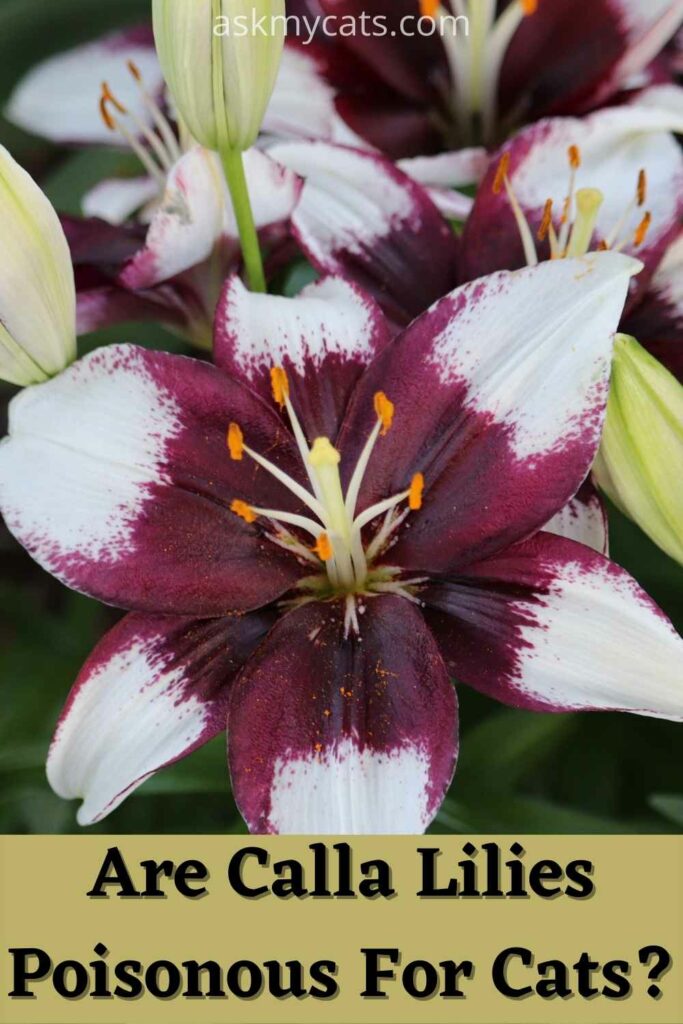Your beautiful cats, born to be curious and analyzing can be found in one of your bedrooms, kitchen, and even backyard to find something amusing and appealing to get their hands on them.
And you sit there being full of contemplations about what would happen if they ingest something toxic always which remains on the top. Don’t worry, I got you.
So today I thought why not take some of such topics that would be helpful for all of you as it was for me. Many of us are stargazed by the appealing presence of lilies and how they are capable of keeping us on our toes for their enamoring beauty.
How would you feel if I tell you they are toxic for a feline?
Yes, today is about knowing what’s behind those gracious lilies. To begin by, just know lilies are extremely toxic and have the properties that give kidney failure to a feline.
Let’s get in more briefly.


Give Your Cat the Perfect Day
Get the Free Ebook!
Can A Cat Survive After Eating Lilies?
Lilies are said to be an extremely toxic plant for cats because of their sensitive digestive systems and lack of a coping mechanism for complex plant-based diets which makes cats highly prone to get the toxins inside their bodies because of their curiosity and inquisitive nature.
In such cases, a cat is only likely to survive if the toxicity is detected in an earlier stage and swift actions are taken. It is very common in such occurrences that a feline’s vital organ which is a kidney will discard responding and turn out to be a kidney failure.
What Should I Do If My Cat Ate A Lily?

It is recommended and advised to take the feline to the nearest veterinary even if your suspect your cat has eaten or ingested a small amount or leaf of lily.
Lilly is hazardous for a cat even if it is eaten in a smaller amount.
Your cat’s vital organs will start shutting down after 2 to 3 hours and there would be no possibility to save it if you exceed the time limit.
Kidney failure is the most common complication that’s been surfacing itself in the past years.
Your feline’s veterinary will conduct a thorough medical and physical examination of the little furry baby to recheck for any symptoms of lily poisoning in your cat, to help the vet be sure, you need to carry the sample of the lily plant to reach on an outcome.
Are Cats Attracted To Lilies?
Cats being the obligated carnivores would still get attracted to the nearby plants because of their textures and the smell they happen to generate. Similarly, they find lilies appealing because of their presence. Being from a wild cat family, cats tend to be analyzing and look for the prey which is the instinct that helps them to be protected and feel safe.
This is the reason why due to curiosity and their general instinct, cats often stick around the plant in the backyard including lilies, which are highly toxic for a feline to ingest or be around.
How Much Lily Is Toxic To Cats?
There is no specification being provided about how much lily is toxic for cats however, it is pretty evident that even 1 or 2 leaves can result in severe kidney failure and if the ingestion goes undetected, the little feline will die in 3 to 4 days once the toxic substance stops the functioning of crucial organs of their body.
Furthermore, it is recommended to not keep the lilies and cats together as cats are born with the tendency to analyze every new addition considering they are very territorial and need reassurance for the same.
How Much Lily Pollen Is Toxic To Cats?

Lily is a toxic plant as a whole and even a single part of it shouldn’t be allowed for your cat to ingest as It is hazardous and can lead to ultimate death in a span of 4 to 7 days.
Lilly pollens are too toxic for the cat as if your cat licks or eats a couple of lily pollen off their fur, it can result in acute kidney failure which is likely to unfold itself as-
- Depression
- Disassociation
- Swelled kidneys
- Lack of appetite
- Unresponsive
These are some of the signs that are very essential to notice and detect If you do suspect your cat has eaten a small portion of the lily pollen.
Is The Smell Of Lilies Toxic To Cats?
You might be wondering why such alluring plants happen to be so hazardous for the little felines, so let us break it to you today,
Lilies generate a perfume alike smell announcing spring which is near to impossible for felines to ignore as cats only have the sense to sniff and identify their surrounding which makes it often difficult to keep them away from lilies which results in ingestion of any part of the plant leading to death, kidney failure and many mental complications.
Why Are Lilies Toxic To Cats?
There have been a lot of speculations related to the topic, however, it’s vastly believed that once a cat ingests a portion of the lily plant, a feline’s body creates a toxic metabolite which further reacts in the form of severe kidney failure and at worst cases, turns out in fatal occurrences.
To add to that, it’s always better to be precautious and not make any of such plants accessible to a feline as they are hazardous for a cat’s sensitive system, through the identification of the toxin that affects only cats are still not found but it’s better for us to keep a subtle distance from them.
Which Lilies Are Toxic For Cats?
True lilies which include tiger, stargazer, oriental varieties, Easter, and daylilies are extremely toxic to cats. every part of these plants is said to be toxic and contain harmful chemicals which should not in any way be ingested by a feline as cats are more prone to develop kidney failure because of the plant.
Even the water in the vase is considered to be toxic for felines as they tend to make a metabolite inside their bodies which further results in the failure of a vital organ like the kidney.
When it comes to the other pets such as dogs, dogs develop a gastrointestinal upset after the ingestion of these flowers which settles down in 2 to 3 days which briefly tells us felines are more at risk of getting lily poisoning.
Which Lilies Are Non-Toxic For Cats?
Okay, I hope I haven’t scared you by telling you all about the lilies that are toxic for your feline, to ease you a little bit, let me bring to you some types of lilies that are non-toxic for the little furry and doesn’t possess any harm to your little friend. Come, take a deep breath and just get in.
- The Blushing Bromeliad
- Easter Cactus
- The Orchid
- Gerbera Daisy
- Echeveria
These are the plants that you can keep in your backyard to increase the beauty of your house with some lilies that are of course, non-toxic.
Isn’t it a treat for you, paw-rents?
Are Calla Lilies Poisonous For Cats?

Calla lilies are indeed poisonous to cats as well as dogs as it comprises of insoluble calcium oxalates which are contained in idioblasts cells. When your cat ingests calla lilies, the idioblasts will burst when comes in contact with their saliva further escalating into penetrating the gastrointestinal and oral walls making it a hazardous environment inside a feline’s body.
To add to that, let me bring to you more such plants that have the same toxicity as calla lilies which you need to keep off from a feline in any case.
- Elephant’s Ear
- Dumbcane
- Peace Lily
- Chinese Evergreen
- Umbrella Plant
Toxicity In such cases can be identified by symptoms like mouth pawing, drooling, severe irritation, inability to swallow are the major signs to look for to detect calla lilies toxicity in cats.
Are Stargazer Lilies Poisonous For Cats?
Stargazer lilies are poisonous and toxic for cats if even a small portion of the plant is ingested because of the extreme levels of toxicity that are inside every part of the plant.
Humans and animals like horses and dogs are not prone to any illness or adverse effect caused by lilies but cats tend to develop major complications such as
- Kidney failure
- Drooling
- Lack of urination
- Lack of appetite
- Death in worst cases
It’s better for the cat’s parents to know every fact before introducing such hazardous and life-threatening plants into the lives of a feline.
Are Peace Lilies Poisonous For Cats?
Peace lilies are poisonous to cats however not that much as true lilies of the genus Lilium and hemerocallis.
Peace lilies contain calcium oxalate which is toxic for the feline to ingest as even a small portion of the plant can give your feline oral irritation and stomach upset in the initial stage which can further end up in kidney failures and an ultimate death too.
Symptoms Of Lily Poisoning
Detection of lily toxicity in cats is easier as the feline who seems to ingest any part or portion of lily is likely to get nauseous usually accompanied by loss of appetite.
The timeline of this symptom to hold the ground is approximately 2-3 hours. Your cat will also have burning sensations in the throat, showing signs of disassociation and lethargy are often the initial stages combined with diarrhea and vomiting.
After 4-5 hours of ingestion, the vital organ such as the kidney will stop its functions resulting in no urination, swelling in glands.
Once the kidney stops working, the waste products will start accumulating in the body which makes the feline breathe heavily capable of resulting in heart failure and in the worst cases, sudden death due to unresponsive organs.
Diagnosis Of Lily Poisoning
there haven’t been any specific tests to detect lily poisoning in one go but veterinaries conduct a physical examination which showcases there are an enlarged or swollen presence of kidneys or not.
The diagnosis is further divided into five levels in which each diagnosis helps to brief the level of toxicity available in a feline’s body.
1.Chemistry Panel
In this diagnosis, the elevated blood urea nitrogen and creatinine are checked, both of which determine the indication of kidney failure.
2. SDMA Test
This test detects signs of early kidney damage with the help of a rapid blood test.
3.Urinalysis
A sample of urine can provide additional information on the extent of kidney damage and urine- concentrating ability.
4.Kidney Ultrasound
This helps the vet to detect the size of the kidney and look for any further complications such as kidney stones, etc.
5.Blood Pressure
Blood pressure is often checked in cats who have ingested lilies as high blood pressures can often be detected as hypertension.
Prevention And Treatment
In such cases, the foremost question that occupies the mind is how to give your feline the first-aid in such occurrences and preventing them from escalating further.
Though the precedence should be to take the feline for an urgent consultation, however, it’s necessary for you to take a few steps to ease down the situation.
- Try to clean your feline’s face with warm water that will help you to get rid of any lily pollen that might be left as a residue.
- Secondly, try to keep your cat warm because toxins can make your cat cold which can further be a reason for pneumonia and seizures in some cases.
- Take the flower as it would be required to check how much your cat has ingested and which part to keep the kidneys of your cat on surveillance.
When it comes to treating this whole unfavorable situation, the veterinary will keep your feline and its kidneys to monitor as lilies are most likely to adversely affect the functioning of kidneys.
The whole period is going to be of 48-72 hours as this much time is officially needed to remove the toxins from a feline’s body.
How To Keep A Cat Away From Lilies?
Now the question that stands tall in front of us is how to keep cats away from lilies even after knowing their inquisitive nature.
Being a furry parent myself, it is quite a difficult decision to make, but here are the mentioned ways through which you can keep your cat from coming near to the lilies.
1.Use Unlikable Plants
The foremost thing you can do is to surround the lily plant with the plants that cats usually don’t like. Some of such plants are citrus, mint, lavender. Cats don’t like the perfume or scent these plants generate which will prevent and eradicate the chances of your cat being around lilies too
2.Use Coffee And Oranges
Cats have a strong dislike towards anything citruses such as oranges and anything too strong like coffee. You can add coffee grounds and orange peels into the soil which will make them dislike the spot where you have kept the lily
3. Use Deterrent Sprays
You can get any deterrent spray from the market and spray it all around where you have kept the lily plant, make sure the spray you are using is pet friendly. Keep the contents of the deterrent spray always in check to prevent any further allergies in the little furry babies.
4. An Unpleasant Surface
Cats are immaculate pets and don’t like to be around anything dirty or unpleasant to them. The thing that you can do is, surround the whole lily plant with an undesirable cloth or surface. You can use tin foil by keeping it down around the planter which will eventually keep the cat far away from the toxic plant.
Frequently Asked Questions
How much lily is toxic to cats?
Lily is toxic if eaten in a small amount of a larger amount. 2 or 3 leaves of lilies are enough to be hazardous and turn out in fatal occurrences for a feline.
Where to keep lilies in a house if we have a cat?
Lilies should not be made accessible to a feline in any case as that will further incline the little furry babies to chew some part of the plant. Refrain away from keeping the plants in any area where your cat is likely to go. Although it is better to not keep the plants in the house to prevent any mishap.
Final Words
At the end of this article, we have come towards the brief conclusion that lilies shouldn’t be made accessible to cats in any way as it comprises of toxins that can result in fatal occurrences and blockage of the crucial vital organs resulting in failures.
To put my words to a halt now, I would like you to tell me your experience about the first time you came to know about such startling facts about lilies? What was your reaction?
Come let’s talk in the comment box.
